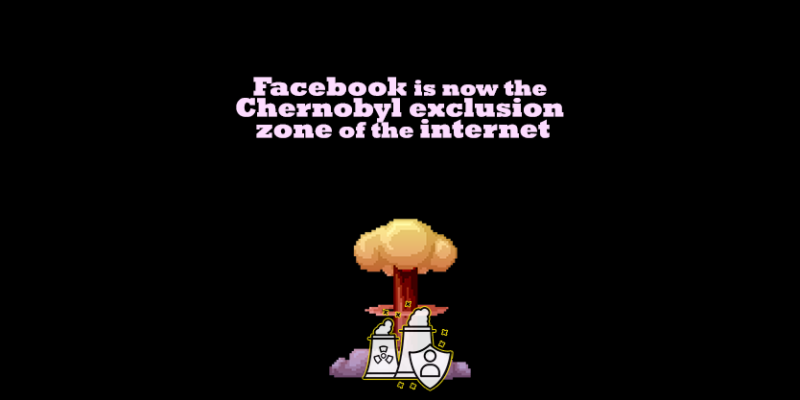The year is 2020,
Facebook has now been around for just over 15 years and has grown into a mammoth super-company with a market cap of over $800billion (CNBC, 2020). At the core of Facebook’s value lies it’s over 2.7 billion monthly users (Statista, 2020) which advertisers pay a hefty premium to engage with.
Facebook is an old school platform, that didn’t particularly age well, from its beginning as a social media platform for use on campuses. In the early days Facebook used to ask users to add a valid university email to sign up in order to make sure that only students (and most importantly, real people) signed up. Currently Facebook still asks users to use their real names (like wtf – do I really want everyone to have such easy access to updates on my life?) in an attempt to “crack down” on fake users. This is just one of the small features of the platform that is alienating privacy conscious millennials, gen z-ers and techies. It only makes sense that Facebook so heavily invested in Instagram years ago – recognising that Facebook refugees and the younger generations would need a differentiated platform to engage on. Instagram has brought back nicknames and other more impersonal usernames, less clutter and a bigger, perceived, degree of privacy.
Tech friendly users are now realising the negative side effects of giving huge companies like Facebook such unprecedented access to their data and browsing habits. The “techies” are now abandoning ship or drastically changing their relationship with the platform and are sounding the alarms to other users. As more and more baby-boomers are now using Facebook as their go-to online platform they are slowly but surely pushing younger users out.
Facebook has become a wasteland of Fake News, ANGRY CAPS LOCK POLITICAL RANTS!!!!, and pseudo-motivational quotes juxtaposed on generic and out of date graphics and visuals.
Furthermore this creates a stressful and non-fun experience for users. Younger internet users are recognising this and going to Tik Tok to just do fun dance routines and interact with others – far away from their aunty’s midnight encounter with the caps lock key.
Who could have guessed that the Gen-Z youth wouldn’t want to share the same platform as their rambling grandmother? Facebook did. And that’s why they invested in Instagram and Whatsapp in order to keep a huge database of users.
Younger users may still have Facebook accounts but are using it less and less and spending less overall time on the platform.
Facebook is now like the Chernobyl exclusion zone of the internet. It is the epicentre of a wider online nuclear meltdown concerning the devastating effects data abuse can have on a social, cultural and political level.
The cat is out of the bag and users are starting to find out what a toxic wasteland it has become. It is no longer capable of sustaining healthy life and soon only some old babushkas* will be left, refusing to leave the platform they’ve become accustomed to. In this article I’m going to analyse the different factors that led Facebook to become the “Chernobyl exclusion zone of the Internet”
*Grannies in Russian – used here not only to signify older users but also less tech-friendly, late adopters of technology.
So how did Facebook end up as the toxic waste ground of the internet?
The algorithm:
The Facebook algorithm is designed to increase engagement. More time spent on Facebook & engagement on posts = more advertising revenue. As you log in the algorithm is constantly working to give users a reason to engage. Please note that this doesn’t necessarily mean it will only show things that make users happy but will prioritise showing things that they think will harness a response.
If that’s your conservative KEYBOARD TAPPING GRANDMOTHER that could be infuriating fringe news of the “liberals wanting to legitimize transgender operations on 6 year olds!!!!!”. Even if this “news story” has very little basis in facts and actual mainstream political agendas (it is usually based on an interpretation of a single Tweet of one of the most crazy people identifying as a Liberal) this is the story which will appear most on these people’s feeds giving them the wrong impression that this is mainstream liberal consensus. The reason why the algorithm shows this article is because it is programmed to trigger engagement. AND WHAT IS MORE ENGAGING THAN WRITING ANGRY COMMENTS ABOUT THOSE GODDAMNED LIBERALS TRYING TO REGENDER OUR KIDS?!!!
Echo Chambers:
Following up on the algorithm, you can imagine what effect this has on users as they see more and more “news” which just confirms their own biased view of the world. The deep polarisation in Western (US and European) politics is largely based on the fact that users may use the same online platforms but experience vastly different online realities.
A moderate liberal will always view liberal mainstream consensus news and only the most fringe / controversial and extreme (which also means stupid, less fact based) of conservative opinions. Again this is because these stories are the most likely to harness a reaction/ response. I.e. there’s not much emotional reaction to some pretty decent/ mainstream conservative views and vice versa. In the same way a moderate conservative will only see mainstream conservative news and only the most fringe of liberal opinions.
This toxic echo chamber of online existence gives an advantage to hardliners of both sides of the debate as people compromise some of their own values to deter the perceived “greater evils” coming from the other side of the debate. I.e. “I’D RATHER VOTE FOR TRUMP THAN FOR THOSE LIBERALS SET ON RE-GENDERING OUR BABIES!”.
Data collecting and selling:
A phrase largely popularised in the mainstream media lately by Netflix’s documentary on the effect of Social Media is “if you’re not paying for the product – you are the product”. Anyone even vaguely following Facebook’s trajectory as a company or as a platform was very well aware that the company was so valuable because it was harnessing huge amounts of data which could be used by advertisers to sell us products.
Most people could have been excused in thinking there was some sort of benevolent algorithm set up by the huge corporation which simply showed users products they would be interested to buy. I.e “I like these sneakers, the algorithm is only showing me things I like – It’s a win win”.
However years and years of data collecting have allowed firms to go much deeper into the human psyche than just superficially judging what type of products they think they would like to see.
Cambridge analytica (the company which rose to infamy by working with the Trump campaign to flood the internet with content aimed at pushing voters towards voting for Trump) had by its own admission (Sky News, 2016) collected over 5000 individual data points on over 220 million Americans.
Today in the United States we have somewhere close to four or five thousand data points on every individual … So we model the personality of every adult across the United States, some 230 million people.
— Alexander Nix, chief executive of Cambridge Analytica, October 2016.
5000 data points are a lot. They’re more than a lot. That’s a fucking shit ton of data for mathematical geniuses to aggregate and make accurate models of. Cambridge analytica, for example, used the Big Five Personality Traits model to model user behaviour (Washington Post, 2015). To get a better idea of what sort of behaviour this could predict, here’s a quick look at the personality traits it identifies:
- openness to experience (inventive/curious vs. consistent/cautious)
- conscientiousness (efficient/organized vs. extravagant/careless)
- extraversion (outgoing/energetic vs. solitary/reserved)
- agreeableness (friendly/compassionate vs. challenging/callous)
- neuroticism (sensitive/nervous vs. resilient/confident)
Deep psychographic analysis over thousands of data points made some of our most vulnerable moments or character traits open to be abused by companies running aggressive online campaigns aimed at nudging users towards not just making a purchase, but even more sinister, a certain political decision.
Suddenly our data is being used to skew election results and change our perception of the world. Not so idyllic now.
Fake News & Disinformation campaigns:
Fake News has to be the key term of the decade. The rise of global interconnectedness brought together the phenomenon of fake news. Disinformation could now spread globally in seconds, which over the years has created a volatile and dangerous mix of online paranoia.
Now consider the level of psychographic data available to bad faith actors* purposely engaging in disinformation campaigns, and you have an increasingly dangerous situation.
*3rd party people/ organisations/ governments who maliciously or with bad intention spread fake news
So what is the future of Social Media?
As more and more people are becoming aware of the toxic effect Facebook is having on society, they are using it less and less. Documentaries such as the social dilemma were watched by tens of millions of people and a wider conversation has already started (at least in Western countries) about how to limit the amount of data these cyber mammoth companies are collecting and how it is distributed.
The speed of this change remains to be seen as is the damage the social media platforms are now spreading in other parts of the world where the platforms are aggressively growing with no oversight whatsoever.
As even non-tech users grow aware of the value these companies reaped from selling their data, and the careless way it was handed over to anyone willing to pay for it, demand for a different type of social platform will grow.
A platform which prioritises privacy and/or charges users a small fee in return for not accessing their data when they interact with the platform is likely to rise in the near future, Let’s hope the digital world hasn’t been scorched to the ground till then….
This article was originally published on GuerrillaGorilla.Co –GuerrillaGorilla.CO is a creative agency & consultancy which helps companies better understand the internet and cut through the noise to target their audience.














